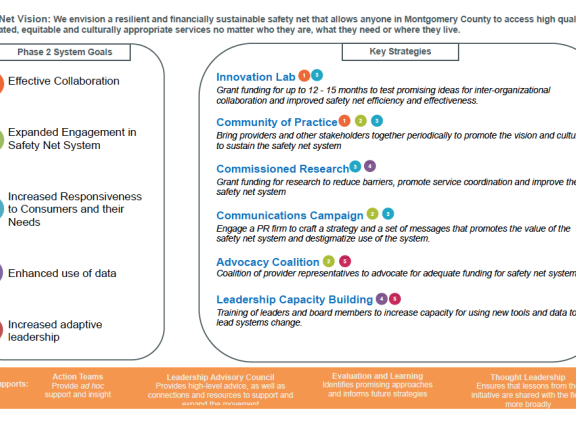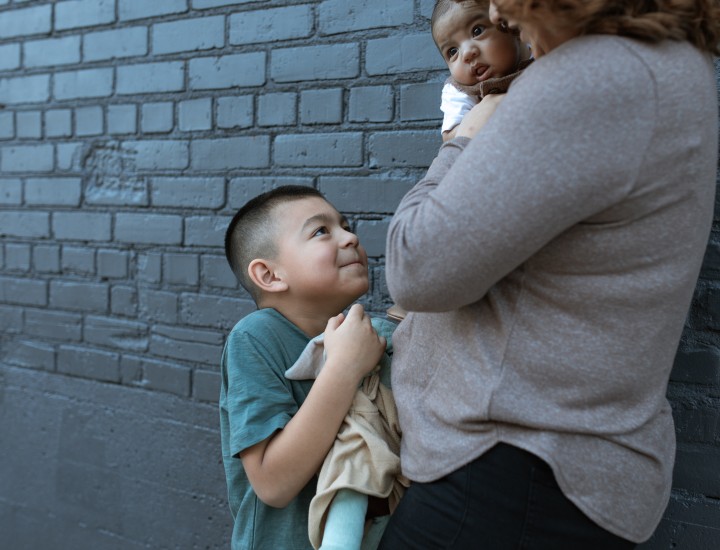HealthSpark pens article for Phila. Social Innovations Journal on the Resiliency Initiative

The Philadelphia Social Innovations Journal released its 54th issue, which includes an article written by Tamela and Russ entitled, "Mending a Frayed Net: HealthSpark Foundation's Safety Net Resiliency Initiative." The article, copied below, can be found on the Social Innovation's Journal's website.
Summary
In an era of shrinking public dollars for safety net services, coupled with negative views about those who need those crucial services, how are nonprofits that provide basic services supposed to survive, let alone thrive?
This was the question we at HealthSpark Foundation started asking in 2016. Armed with statistics about, and buy-in from, our nonprofit community, in 2018 we launched our Safety Net Resiliency Initiative, aimed at strengthening the financial resiliency of the safety net system.
Last year, we coordinated four Design Teams for nonprofits and representatives from our county government to brainstorm ideas to improve safety net resiliency. Ideas were vetted through larger community meetings called the Community of Practice, and at the end of the year we offered grants for collaborative pilot projects through our new Innovation Lab.
Throughout it all, we have worked with consultants at Equal Measure who documented lessons learned:
- Providing stipends to Design Team participants acknowledged the time it takes to build networks and engage differently;
- A strategic vision must be balanced with the realities of providing vital services; and
- It is crucial to involve the whole community in this work (consumers, first responders, courts, local businesses, etc.).
For the next phase of the initiative, we are launching a new leadership capacity building training series designed to further build our provider community's systems thinking “muscle” and monitoring the Innovation Lab grants and coordinating a learning community for those grantees. We will also begin working with a public relations firm to develop a communication campaign and related advocacy coalition to build support for a strong safety net among policymakers and the general public. Additional activities planned for the year will both expand and deepen the impact of this work.
Introduction
In an era of shrinking public dollars for safety net services, coupled with increasingly negative views about those who need those crucial services, how are nonprofits that provide basic services supposed to survive, let alone thrive?
We at HealthSpark Foundation have long been interested in improving the health and human service system so that it operates more efficiently and effectively, and this was the question we asked ourselves in 2016.
Two reports written by Oliver Wyman, Sea Change Capitals, and Guidestar (now Candid) in 2017 further informed our thinking. Among the findings in the first report, “The Financial Health of Philadelphia Area Nonprofits,” commissioned by The Philadelphia Foundation, were that more than 40 percent of area nonprofits have no operating reserves and more than 20 percent have less than one month of cash reserves.1
The second report, “A National Imperative: Joining Forces to Strengthen Human Services in America,” commissioned by the Alliance for Strong Families and Communities and the American Public Human Services Association, presented a similar dire financial picture for health and human service organizations nationwide.2
These reports, and internal and external conversations with a variety of stakeholders over a two-year period, led us to launch the Safety Net Resiliency Initiative, a 10-year effort that seeks to improve the financial resiliency of the safety net system in Montgomery County.
One year into the work, the lessons we have learned are informing our journey forward.
The Safety Net System
The safety net system is a complex web of services intended to provide both short- and long-term support to those who need assistance. Ten basic services comprise the safety net system:
- Childcare
- Education
- Food
- Healthcare
- Housing
- Job Training
- Substance Abuse Treatment
- Transportation
- Utility Assistance
- Violence Prevention
We recognize that there is a subset of the population who, once they need safety net services, will always need them. We also recognize there is another larger subset of the population who need services for only a short period of time so they can “bounce back” to self-sufficiency. For the safety net system to more efficiently serve those who need services on an ongoing basis, our initiative focuses on shorter-term interventions.
Background Work
We began working with nationally recognized and locally based consultants at Equal Measure, who have been our thought partners on this journey. Before long, we realized we needed to test out assumptions with the nonprofits providing the boots-on-the-ground support and our county leadership who also provide and fund safety net services.
In addition to preliminary surveys and focus groups, in the fall of 2017 we hosted two crowdsourcing events planned and facilitated by national communications consultants Spitfire Strategies. Seventy organizations and representatives from the county's health and human services participated in at least one of these half-day meetings that affirmed our view of a safety net system in distress. Participants then created a new vision for the county's safety net system:
“We envision a resilient and financially sustainable safety net system that allows anyone in Montgomery County to access high quality, coordinated, equitable, and culturally appropriate services no matter who they are, what they need, or where they live.”
Many in attendance committed to continuing the work to bring that vision to reality.
Phase One
With our provider community engaged, we launched the Safety Net Resiliency Initiative in January 2018 with a set of activities for the year crafted to help the system start on the journey to more financial resiliency.
From March through August, more than 50 organizations -- along with representatives from county government -- participated in monthly meetings in at least one of four Design Teams, each centered around a portion of the safety net system infrastructure that crowdsourcing event attendees thought were crucial to make important changes:
- Public-Private Collaboration;
- No Wrong Door Access to the Safety Net;
- Data Sharing and Systems Integration; and
- Advocacy and Communications.
Capacity for Change led the Design Teams through a process to create and vet ideas. In recognition of the time needed to do this work, all participating organizations received a $6,000 stipend they could spend as they wished.
Along the way, we hosted three “Community of Practice” meetings, also facilitated by Capacity for Change, to introduce the initiative to a wider audience and seek feedback on the Design Teams' ideas. We saw increasing attendance at these meetings, which included Design Team participants, county officials, and others who interact with the safety net system such as police and school district representatives, municipal employees, and consumers.
One strategy that emerged from the Design Teams was to support a research and development approach for nonprofits to test out new ideas. In response, we created the Innovation Lab that offered grants to support 12 to 15 month pilots or proofs of concept to test ideas that have the potential to increase the financial resiliency of the safety net system. Projects were required to be collaborative with one lead organization and at least one other participating organization.
By early 2019, we awarded nearly $320,000 in 10 grants, including:
- $50,000 to Montgomery County OIC to establish a one-stop access point for safety net services to those re-entering the community from the criminal justice system;
- $35,500 to the Pottstown Cluster of Religious Communities to pilot a training program to help consumers build their leadership skills to volunteer and connect with nonprofits in new ways;
- $10,000 to Your Way Home Montgomery County to advance equitable access to housing and homeless services for Lesbian, Gay, Bisexual, Transgender, and Queer/Questioning youth, adults, and seniors; and
- $50,000 to the MontCo Anti-Hunger Network to pilot programs to meet the food needs of vulnerable populations, including an online ordering and delivery service at two food pantries recently profiled by the Philadelphia Inquirer.3
Phase One Lessons Learned
Throughout 2018, we worked with our partners at Equal Measure to evaluate the initiative and look for early signs of systems change. They found shifts in providers' mindsets, including an increased comfort with uncertainty and a switch from programmatic to systems thinking. There was also evidence of an evolution from “me” to “we” as understanding increased about providers' roles in the larger safety net system. Equal Measure observed that a movement is building as we drew new audiences into the conversation.
Equal Measure identified some key lessons from Phase One:
- Providing stipends to Design Team participants acknowledged the time it takes to build networks and engage differently;
- A strategic vision must be balanced with the realities of providing vital services; and
- It is crucial to involve the whole community in this work (consumers, first responders, courts, local businesses, etc.).
We are incorporating those lessons into Phase Two of the initiative, which has just begun.
Phase Two
As detailed in the graphic, the second phase of the Resiliency Initiative has several components.
We will monitor the progress of the projects funded through our Innovation Lab. We will also launch a Learning Collaborative, facilitated by Capacity for Change, to periodically convene grantees and their partners to discuss their projects, progress, and emerging lessons and seek feedback from their peers.
Leadership Capacity Building Training Program
In the spring, we will launch a leadership training program in partnership with the Nonprofit Executive Leadership Institute (NELI) at Bryn Mawr College. More than a dozen organizations were accepted to participate in this institute meant to strengthen the capacity and financial resiliency of both the providers and the safety net system.
From March through October, a cohort of staff and at least one board member from each participating organization will progress through a series of daylong workshops on topics such as Leading Systems Change, The Role of Financial Management and Planning in Systems Change, Engaging Staff in Systems Change and The Role of the Board in Systems Change. Nonprofit and community leaders helped inform the topics and structures to support learning.
Communications Campaign and Advocacy Coalition
At the same time, we will begin working with a public relations and communications firm to develop strategies and messaging to shift public and policymaker dialogue about the safety net system. We will also establish a cross-issue Advocacy Coalition comprised primarily of safety net providers to advocate on behalf of the entire safety net system, transcending organizational boundaries. Through these efforts, we expect a shift in policymakers' views to support funding for, and an increase in the public's understating about the importance of, a strong safety net system, as well as reduced stigmatization for those accessing the system.
Additional Activities
We will develop the rest of the ideas outlined in the graphic over the course of the year and are likely to announce further activities at our next Community of Practice meeting, scheduled for the end of June.
Conclusion
We will continue to work with Equal Measure and our community stakeholders to deepen our learnings. And we will share those with anyone interested in having a strong safety net. If you would like to join us on this journey, visit www.healthspark.org for more information and to request periodic updates.
While we are unsure of exactly where this journey will lead us, we know that this is a journey we must make in order to achieve the vision our community has created for the safety net system. A strong and resilient safety net is vital to ensuring that all who need help may receive it.
Works Cited
1 Oliver Wyman, Sea Change Capitals and Guidestar (now Candid), The Financial Health of Philadelphia Area Nonprofits, (2017), page 5.
2 Oliver Wyman, Sea Change Capitals and Guidestar (now Candid), A National Imperative: Joining Forces to Strengthen Human Services in America, (2017).
3 Lubrano, Alfred, “A digital effort to fight hunger in Montgomery County.” Philadelphia Inquirer,January 29, 2019.


